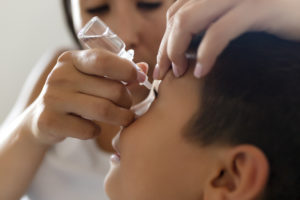October 17, 2022
By Dwight Akerman, OD, MBA, FAAO, FBCLA, FBCLA
 Topical low-concentration atropine is widely prescribed for myopia progression control in children and adolescents. Currently, topical atropine does not have an FDA labeling indication for treating myopia progression, and thus is only available in the United States from compounding pharmacies. However, three pivotal phase three clinical trials are currently being conducted in the United States with topical low-concentration atropine. Hopefully, FDA clearance for various commercial formulations is on the horizon.
Topical low-concentration atropine is widely prescribed for myopia progression control in children and adolescents. Currently, topical atropine does not have an FDA labeling indication for treating myopia progression, and thus is only available in the United States from compounding pharmacies. However, three pivotal phase three clinical trials are currently being conducted in the United States with topical low-concentration atropine. Hopefully, FDA clearance for various commercial formulations is on the horizon.
The purpose of this study was to ascertain low-concentration atropine’s reported compounding and labeling in the United States. U.S. compounding pharmacies were identified through a survey of eye doctors, social media, conferences, and web search. A total of 28 pharmacies were identified and contacted through telephone and asked a standard set of questions about their methods to compound and label low-concentration atropine.
Of those, 26 pharmacies across 19 states provided responses, with 21 answering all nine items (81%) and a mean of 8.7 of nine responses. The most frequently reported bottle size was 5 mL. For storage, 10 pharmacies (38%) recommended refrigeration, and 16 (62%) stated room temperature was sufficient. The median beyond-use date provided was 65 days. For preparation, 12 pharmacies (50%) used commercially available 1% solution, nine (38%) used powdered atropine, two (8%) used both, and one (4%) stated their approach was proprietary. For the added excipients, 11 (42%) used artificial tears only, six (23%) added 0.9% saline only, seven (27%) used more than one ingredient, and two (8%) were proprietary. Only two pharmacies mentioned adding boric acid, and two mentioned “pH-adjusted” saline.
The researchers concluded that there is a wide variety of formulation methods in the United States, which may affect atropine stability and potency. Similarly, there are a wide variety of storage and beyond-use recommendations. The researchers also concluded that further research is needed to assess how these variations may affect the efficacy and safety of low-concentration atropine for myopia progression control.
Abstract
Compounding of Low-Concentration Atropine for Myopia Control
Richdale, Kathryn OD, PhD; Tomiyama, Erin S. OD, PhD; Novack, Gary D. PhD; Bullimore, Mark A. MCOptom, PhD
Objectives: Low-concentration atropine is commonly prescribed to slow myopia progression in children but is not Food and Drug Administration-approved for that indication and is only available in the United States from compounding pharmacies. The purpose of this study was to ascertain its reported compounding and labeling in the United States.
Methods: U.S. compounding pharmacies were identified through a survey of eye doctors, social media, conferences, and web search. Twenty-eight pharmacies were identified and contacted through telephone and asked a standard set of questions about their methods to compound and label low-concentration atropine.
Results: Twenty-six pharmacies across 19 states provided responses, with 21 answering all nine items (81%) and a mean of 8.7 of nine responses. The most frequently reported bottle size was 5 mL (interquartile range [IQR]: 3.5-10). For storage, 10 pharmacies (38%) recommended refrigeration, and 16 (62%) stated room temperature was sufficient. The median beyond-use date provided was 65 days (IQR: 45-158). For preparation, 12 pharmacies (50%) used commercially available 1% solution, 9 (38%) used powdered atropine, 2 (8%) used both, and 1 (4%) stated their approach was proprietary. For the added excipients, 11 (42%) used artificial tears only, 6 (23%) added 0.9% saline only, 7 (27%) used more than one ingredient, and 2 (8%) were proprietary. Only two pharmacies mentioned adding boric acid, and two mentioned “pH-adjusted” saline.
Conclusions: There were a wide variety of formulation methods in the United States, which may affect atropine stability and potency. Similarly, there are a wide variety of storage and beyond-use recommendations. Further research is needed to assess how these variations may affect the efficacy and safety of low-concentration atropine and myopia control.
Richdale, K., Tomiyama, E. S., Novack, G. D., & Bullimore, M. A. (2022). Compounding of Low-Concentration Atropine for Myopia Control. Eye & Contact Lens, 10-1097.
DOI: 10.1097/ICL.0000000000000932













